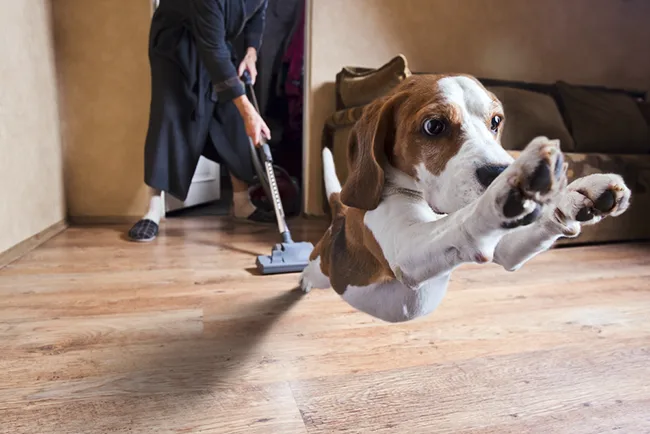Have you ever noticed how your lovable, tail-wagging pet suddenly turns into a scared, furry bundle of nerves the moment you switch on the vacuum cleaner? It’s a common scenario for many dog owners across the country. ‘Why are dogs scared of the vacuum?’ is a question that has puzzled many of us as we watch our brave pets scurry away from this common household appliance. In this article, we’re going to break down this intriguing behavior in a way that’s simple and easy to understand. From the loud noise to unexpected movements, past negative experiences, invasion of their territory, and lack of early exposure, there are numerous reasons that might explain this fear. Let’s explore these elements in depth to help us understand our furry friends better and possibly even help them overcome this fear.
Why are Dogs Afraid of Vacuum Cleaners?
It’s not true that every dog is scared of vacuum cleaners, but a lot of them definitely are. When the vacuum starts up, you might see your dog acting differently. They might start to bark, jump around, or behave strangely. As a dog owner, you might notice these changes right away.
There are a bunch of reasons why a vacuum might scare a dog. Let’s dive into those.
1. Loud Noises
The loud noise of a vacuum can indeed scare a dog. Dogs have a highly developed sense of hearing; in fact, they can hear sounds at higher frequencies and from further away than humans. This means a vacuum’s noise can be particularly loud and potentially distressing to them.
The sudden, loud noise of a vacuum can startle a dog, making them feel scared or anxious. In addition, the constant humming noise might seem threatening to them. It’s similar to how some people might feel uncomfortable or anxious with the sound of a loud thunderstorm or fireworks.
Moreover, dogs use their sense of hearing to detect danger. A vacuum’s loud noise interrupts this detection and might cause them to perceive it as a potential threat, leading to fear or anxiety.
2. Vibrations and Movements
Vibrations and movements of a vacuum can certainly scare a dog. Dogs are very sensitive to vibrations and sudden movements in their environment. When a vacuum starts, it doesn’t just make noise, it also vibrates and moves around.
To a dog, this can be startling and confusing. They might not understand what the vacuum is or why it’s moving and vibrating. This uncertainty can lead to fear.
Also, dogs are creatures of habit. They like their environment to be predictable. The unexpected movements of the vacuum disrupt this predictability, which can cause anxiety. So, even though to us it’s just cleaning, to dogs it could be something scary and unknown.
3. Unfamiliarity
Dogs rely heavily on routine. Anything that disrupts their daily pattern can be a source of stress. For many dogs, the vacuum only makes an appearance once a week or even less frequently. This lack of regular exposure means that they never truly get accustomed to it, making each encounter as nerve-wracking as the last.
4. Size and Appearance
To a smaller dog like a Cockapoo or a chihuahua, a vacuum can be intimidating simply because of its size. It’s a large, looming object that moves unpredictably. Even for larger breeds, the vacuum’s appearance and the way it moves can be off-putting.
5. Negative Associations
If a dog has had a bad experience with a vacuum in the past, such as being accidentally bumped by it, they might associate the vacuum with negative feelings. This past trauma can exacerbate their fear.
6. The Evolutionary Perspective
To further understand our dogs’ aversion to vacuums, it’s essential to consider their evolutionary history. Wild canines, the ancestors of our domesticated dogs, relied on their acute senses for survival. A sudden, loud noise could signal danger, like an approaching predator or a rival pack. Reacting quickly to these noises was often a matter of life or death. Thus, our modern dogs’ fear response to the vacuum’s roar might be an ingrained survival instinct from their wild ancestors.
7. The Smell Factor
Another aspect we often overlook is the vacuum’s impact on a dog’s keen sense of smell. As the vacuum sucks up dust, dirt, and household debris, it also stirs up a myriad of scents. For a creature that communicates and understands the world primarily through smell, this sudden onslaught of odors can be disorienting and alarming.
What Should You Do if Your Dog is Afraid of the Vacuum Cleaner?
If your dog freaks out when you bring out the vacuum cleaner, don’t worry. There are some simple steps you can follow to help your pet feel less scared and make it easier for you to clean your house when your pet is around.
Don’t get mad at your dog for being scared of the vacuum cleaner.Keep in mind that if your dog is growling or snapping at the vacuum cleaner, it’s because they’re scared. Don’t punish them for this. Instead, give them some space from the vacuum at first. You might want to keep the vacuum in a different room until you’re ready to start helping them get used to it.
Let your dog get to know the vacuum cleaner when it’s off and quiet.Keep the vacuum still, don’t move it around. Let your dog sniff it and get to know it. You could even try putting it next to their bed or favorite spot.
Slowly move the vacuum cleaner around, but don’t plug it in.Think about giving your dog treats from a distance that feels safe to them. This could be their favorite food, some peanut butter, or special dog treats. You know what your dog likes best, so use that to help them feel more positive about the vacuum cleaner. As time goes on, let your dog come closer to the vacuum cleaner while you push it around. Make sure to keep it off so it won’t scare them.
Once your dog is okay with the vacuum moving around, then you can turn it on.Having a friend with you can be helpful when you’re ready to turn on the vacuum cleaner for the first time. First, make sure your dog is far away from the vacuum and distracted by something else. Then, turn the vacuum on. You want to be far enough away that your dog won’t panic when they hear the vacuum cleaner. When your dog stays calm, give them lots of treats and praise. As time goes on, you can bring the vacuum closer.
Don’t tease or scare your dog with the vacuum cleaner to avoid making them more scared.Sometimes, dogs get scared of vacuums because someone chased them with it or tried to vacuum their fur or paws while playing. Even a calm dog can get scared by these things. Instead, make sure that your dog has only positive experiences with the vacuum cleaner.
Dealing with a dog that’s scared of vacuum cleaners can be really tough. Luckily, these strategies can help you make your dog feel less scared and more comfortable. If you’re looking for other ways to help your pet have a happier life, reach out to us to learn more about our products.”
Conclusion
In the end, it’s pretty simple why dogs are scared of the vacuum. The noise, the weird movements, and the shaking can all freak a dog out. But, by taking a little time and using some smart tricks, you can help your dog get used to it. Just remember, every dog is different, so what works for one might not work for another. With a little patience and understanding, you can make vacuuming less scary for your dog.

